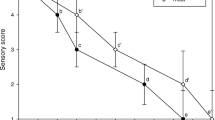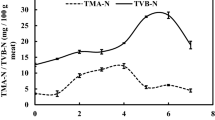Abstract
Indole levels have been used to confirm the sensory evaluation of shrimp decomposition and a limit of 250 μg/kg has been used in several countries to differentiate passable shrimp from shrimp in the first state of decomposition. However, no data exist on the correlation between sensory quality and indole content in deepwater pink shrimp (Parapenaeus longirostris) which validate the use of this defect level. The sensory, microbiological and biochemical changes were determined in microbiologically contaminated (4 and 7 log cfu/g ) deepwater pink shrimp stored at 0, 5, 10 and 15°C. Indole, TMA-N, TVB-N, pH, TVC, Enterobacteriaceae and Pseudomonas spp. increased with time and temperature. At low temperature storage, final indole levels in severely decomposed shrimp (TVB > 60 mg/kg) were much lower than the suggested defect level of 250 μg/kg shrimp. Increased microbiological contamination (7 log cfu/g) induced faster and higher indole production at all temperatures. At higher storage temperatures, indole formation was greatly accelerated resulting in very high indole levels. High indole levels indicate decomposition; however decomposed shrimp may not necessarily contain indole. The shelf life of shrimp ranged from 15 h at 15°C to 6 days at 0°C. An indole defect level >90 μg/kg shrimp should be used for deepwater pink shrimp.












Similar content being viewed by others
References
Direcção Geral das Pescas e Aquicultura (DGPA) (2001) Datapescas. Série Estatística. Lisboa Portugal
Declerck D, van Hauwaert H (1981) Mededelingen van het Rijksstation voor Zeevisserij (C.L.O. Gent), publikatie nr.174-VB/VV (i.W.O.N.L.) 27
Smith R, Nickelson R, Martin R, Finne G (1984) J Food Prot 47:861–864
Food and Drug Administration (FDA) (1982) The food defect action levels: current levels for natural or unavoidable defects in food for human use that present no health hazard. 200 C Street, S.W., Washington, DC, 20204, USA
Chang O, Cheuk WL, Nickelson R, Martin R, Finne G (1983) J Food Sci 48:813–816
Dunggan RE, Starsburger LW (1946) Assoc Off Agric Chem 29(2):177–188
Mendes R, Huidobro A, Lopez-Caballero E (2002) Eur Food Res Tech 214:125–130
ISO/TC 34/SC 12 N 411 (2000) Sensory analyses-general guidance for the design of test room (11.05.2000). Reactivation of the revision of ISO 8589: 1988 International Organization for Standarization
Cobb BF, Alaniz I, Thompson CA Jr (1973) J Food Sci 38:431–436
Veciana-Nogues M, Hernandez T, Marine-Font A, Vidal-Carou M (1995) J AOAC Int 78(4):1045–1050
Chambers TL, Staruszkiewicz AW Jr (1981) J Assoc Off Anal Chem 64(3):603–606
Oetjen K, Oehlenschläger J (1999) In: Georgakis SA (ed) Proceedings of 29th WEFTA Meeting. 10–14 October, 1999-Pieria, Greece. Greek Society of Food Hygienists and Technologists, pp 92–99
International Commission on Microbiological Specification for Foods (ICMSF) (1998) In: Microorganims in foods, vol 6. Blackie Academy Professional, London, pp 130–189
Cobb BF (1977) In: Tropical Products Institute London (eds) Handling, processing, marketing of tropical fish, pp 405–411
Cheuk WL, Finne G, Nickelson R (1979) J Food Sci 44:1625–1628
Vongsawasdi P, Noomhorm A (2000) J Aqua Food Prot 9(3):57–70
Nunes ML, Campos RM (1986) Proceedings of “4 ° Congresso do Algarve” Racal Clube, pp 497–505
Chung CY, Lain JL (1979) Nat Sci Counc Monthly (R.O.C.) 7:1136–1141
Establier R (1969) Inv Pesq 33:55–58
Iyengar JR, Visweswariah K, Moorjani MN, Bhatia DS (1960) J Fish Res Bd Canada 17:475–485
Finne G (1982) In: Martin RE, Flick GJ, Hebard CE, Ward DR (eds) Chemistry and biochemistry of marine food products. AVI Publishing Co., Westport, pp 323–331
Angel S, Basker D, Kanner J, Juven BJ (1981) J Food Technol 16:357–366
Stansby ME (1963) In: Krieger RE (ed) Industrial fishery technology. Publishing Co. Huntington, New York
European Commission Decision 95/149/EC: Official Journal L 097, 29/04/1995 pp 0084–0087
Montgomery WA, Sidhu GS, Vale GL (1970) CSIRO Food Preserv Quart 30:21–26
Mietz JL, Karmas E (1977) J Food Sci 42:155–158
López-Caballero ME, Gonçalves A, Nunes ML (2002) Eur Food Res Technol 214:192–197
Huidobro A, Lopez-Caballero E, Mendes R, (2002) Eur Food Res Technol 214:469–475
Yamanaka H (1989) J Food Sci 54:1133–1135
Shamshad SI, Nisa KU, Riaz M, Zuberi R, Qadri RB (1990) J Food Sci 55:1201–1205, 1242
Matches JR (1982) J Food Sci 47: 1044–1047, 1069
Salwin H (1964) J Assoc Off Agric Chem 47:57–64
Acknowledgements
This research was funded by a CRAFT project—QLK1-CT-2002-71517, CRUSTAMEL: “New approaches to the crustacean prevention of melanosis and quality indices”
Author information
Authors and Affiliations
Corresponding author
Rights and permissions
About this article
Cite this article
Mendes, R., Gonçalves, A., Pestana, J. et al. Indole production and deepwater pink shrimp (Parapenaeus longirostris) decomposition. Eur Food Res Technol 221, 320–328 (2005). https://doi.org/10.1007/s00217-005-1171-y
Received:
Revised:
Published:
Issue Date:
DOI: https://doi.org/10.1007/s00217-005-1171-y




